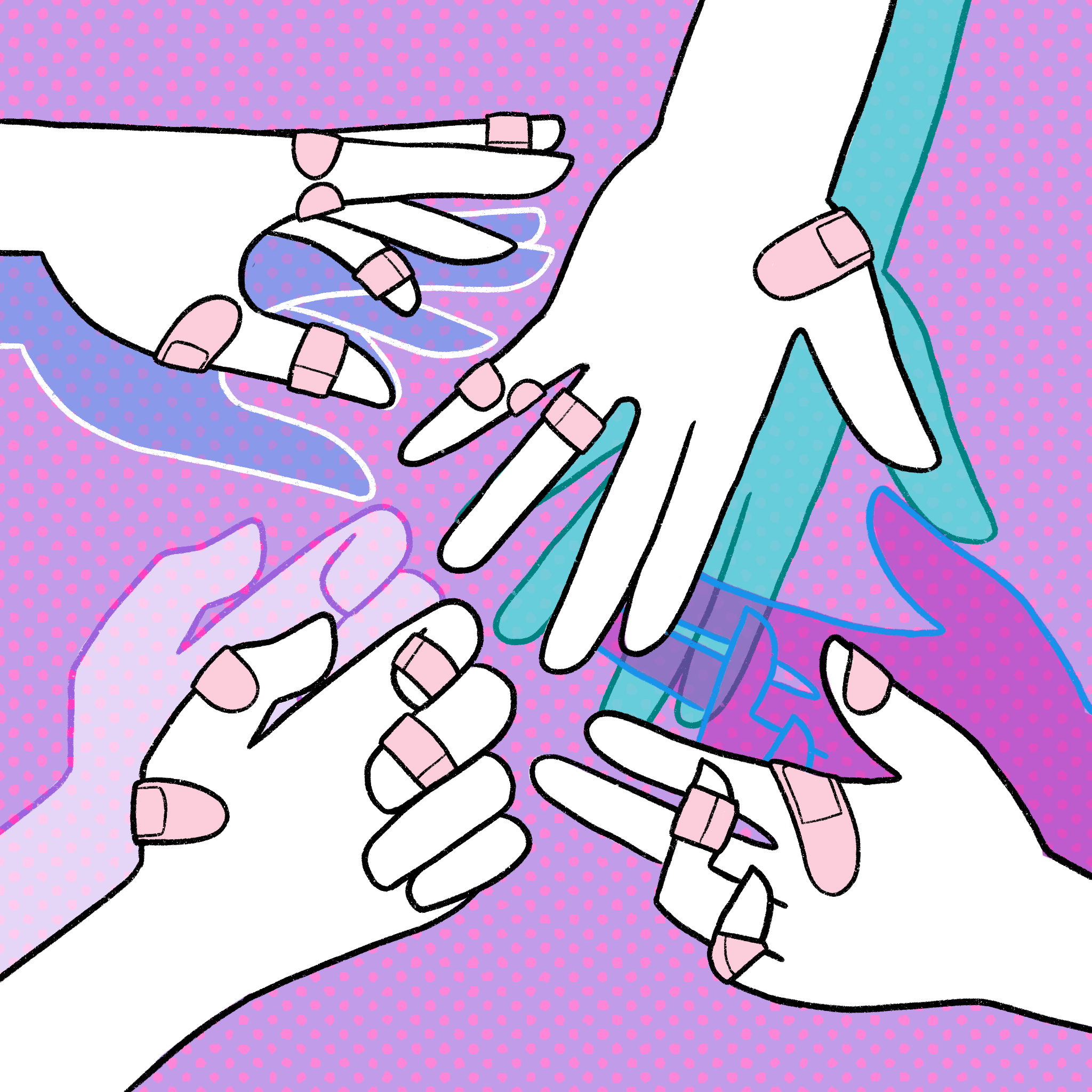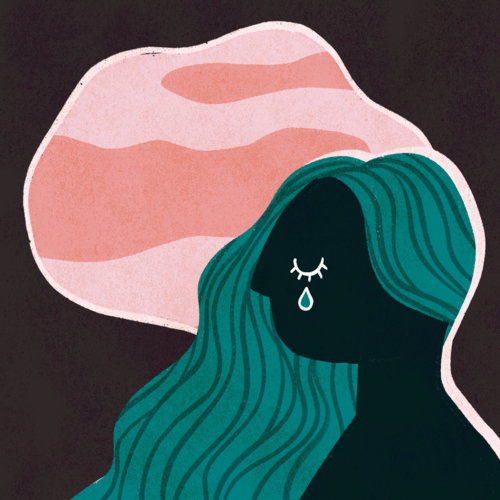Band Aids
How I cultivated a really bad habit — and my vow to stop it.
Illustration by Ally Hart
You know how every 14-year-old girl has some kind of bubblegum scented hand sanitizer in her bag? They’re usually bright pink and definitely have no antibacterial properties, but it was the must-have accessory for a teen who’s favorite activity was fitting in. Anyway, hand sanitizer was über cool, and I couldn’t use it.
I’d be sitting at the lunch table, and my friend would reach for her bag and pull out the latest shimmery tub of checkout aisle alcohol goop, then proceed to offer it to everyone at the table. As an onlooker to this phenomenon, people are usually delighted by the goo, rubbing their hands and slapping it all over and taking a big sniff. So, everyone gets offered the sacred vial, including me.
“No, no thank you.” I shake my head bashfully. “Thank you!” I croak out. I’m the only person to deny myself the pleasure of the artificial candy stink, because if I was to apply hand sanitizer, the wounds and scrapes that I inflict all over my fingers would get a nasty shock.
I have a condition called dermatillomania, which according to Mental Health America is “a mental illness related to obsessive-compulsive disorder. It is characterized by repeated picking at one’s own skin which results in skin lesions and causes significant disruption in one’s life.”
In simpler terms, it’s a condition that prevents me from partaking in hand sanitizer rituals, weird foot masks, and a career in hand modeling. Skin picking manifests for me in the process of tearing my thumbs to shreds, leaving them red and bleeding with blood under my fingernails, lightly staining the sleeves of many coats. I’ve spent a long time picking my skin, my earliest memory of it occurring was during a Brownies meeting. I must have been 8 or 9, and I remember sitting cross legged on the floor with the rest of the group. I think it was the first time I realized that I was actually causing myself to bleed, because I remember the dried blood surrounding my nail, stripes of it staining my finger. I had stopped paying attention to the Brown Owl (elderly lady scout leader) way before I’d noticed.
Dermatillomania comes in all forms. For some people, it’s their arms and their face, for others it’s their chest, the bottoms of their feet. My fingers aren’t the only victims of my compulsion. I can never leave a scab alone, and dry skin doesn’t stand a chance with me. It all comes off without a second thought. The MHA website states that there is no found cause, only a link to OCD and to family members who have picked ... both of which are true for me.
“Skin picking manifests for me in the process of tearing my thumbs to shreds, leaving them red and bleeding with blood under my fingernails, lightly staining the sleeves of many coats.”
But why do I do it, and how do people react?
It comes when I’m stressed, usually, like a destructive poltergeist with no boundaries. I zone out for two minutes and then it’s bloody fucking carnage, blood gruesomely underneath my nails and wedged into my fingerprints, a sticky and ugly reminder that no matter how much I try to control something (namely the picking), sometimes I just can’t. Even if it’s something of my own doing. In fact, throughout the course of writing down these experiences and trying to articulate exactly how I felt, I found myself picking more. Maybe I became hyper aware of my compulsion, maybe I was just insecure about my habit, but there were periods where I would spend hours watching something mind numbing on Hulu and tearing my feet until I could barely walk.
The cornerstones of recovery are the people who help you through it. The kind friends who hold my hand when I’m anxious, or let me fiddle with whatever they have on hand. Their kindness makes me want to get better, but the mystery of dermatillomania is that there isn’t much of a cure, just treatment. Treatment of the mind, the body. I had a friend text me and tell me about “the rubber band method” (where you flick a rubber band on your wrist whenever you want to pick) and the MHA suggested cognitive behavioral therapy … but the real fix for derma has to come from me. I have to want to stop picking.
I remember sitting in my doctor’s office, maybe a month or two before my long-awaited OCD diagnosis, and I expressed to him in kind that I was concerned about the volume of picking I’d been indulging in. He shrugged it off, said it was something that only people with OCD face. Didn’t ask me anymore questions. There’s a lack of awareness in the medical community regarding dermatillomania, whether online or in the office, and as mentioned previously, there’s currently no known cure.
People have to understand that my experience is not unique. The life of a dermatillomania sufferer usually goes hand in hand with an OCD sufferer. The disorders are not only intrinsically linked, but they are understood to be on the same wavelength.
“The life of a dermatillomania sufferer usually goes hand in hand with an OCD sufferer.”
I don’t think I’m asking for a cure for either disorder. OCD is a debilitating, but eventually manageable disorder once treated with therapy and/or medication, and logically, so is dermatillomania, but I think that I’ve been working so hard on calming down my intrusive thoughts, a common symptom of OCD that stresses me out so severely that I hurt myself in the process, a snake eating its own tail type of situation, except the snake is my nails, and the tail is any scab, any scratch, or any piece of flaky skin that I can (and will) locate.
My vow starts here. Not because I want the nail salon to be less of a painful experience, and not even because I want to use hand sanitizer, but because I want to quit. I’m tired of bleeding, I’m tired of explaining myself, and I’m tired of getting blood all over my nice clothes. Getting better is just an idea without the effort, and I want to get better. Wish me luck.










